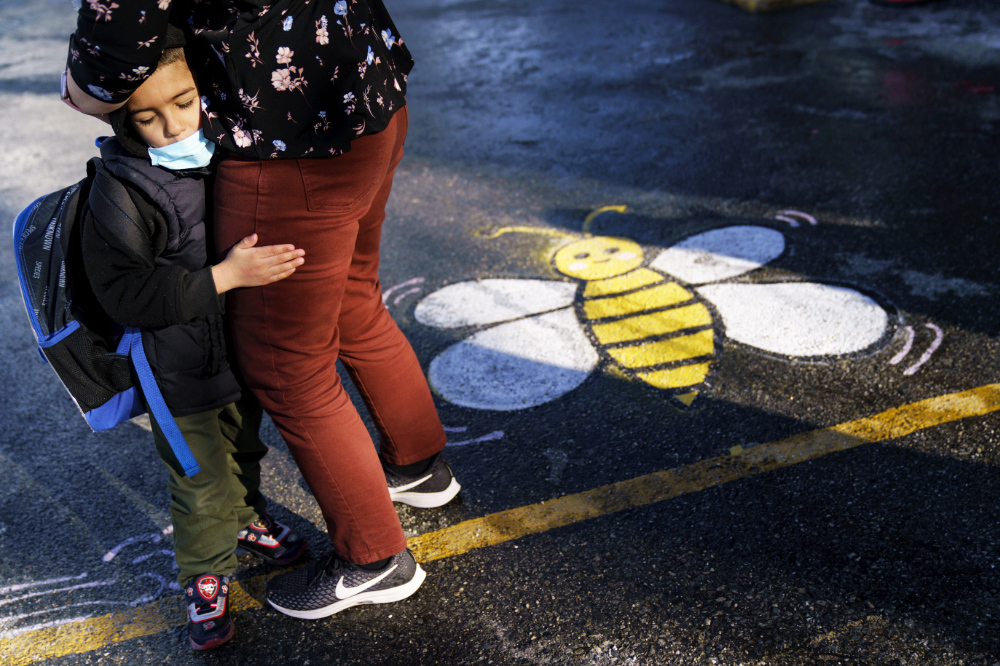WASHINGTON: Facing growing pressure to ease up on pandemic restrictions, the White House insisted Wednesday it is making plans for a less-disruptive phase of the national virus response. But impatient states, including Democratic New York, made clear they aren’t waiting for Washington as public frustration grows.
Gov. Kathy Hochul announced that New York will end its COVID-19 mandate requiring face coverings in most indoor public settings — but will keep it for schools. Illinois announced the same.
Earlier this week, New Jersey, Connecticut and Delaware all disclosed plans to join states that have lifted or never had mask requirements for their schools, and Massachusetts will follow suit at the end of the month. All but Massachusetts have governors who are Democrats, like President Joe Biden.
Biden, who has long promised to follow to “follow the science” in confronting the pandemic, is hemmed in, waiting for fresh guidance from federal health officials, who so far still recommend that nearly all Americans wear masks in most indoor settings.
Defending Biden, press secretary Jen Psaki acknowledged that while people are tired of masks and “we understand where the emotions of the country are,” the administration is following the advice of medical experts who rely on scientific evidence.
“That doesn’t move at the speed of politics; it moves at the speed of data,” she said.
Clearly feeling the pressure, the White House for the first time acknowledged movement in its planning, saying conversations have been under way privately to develop plans for guiding the country away from the emergency phase of the pandemic.
Federal COVID-19 coordinator Jeff Zients said officials are consulting with state and local leaders and public health officials on potential next steps. But as governors and local officials press for clearer federal guidelines for easing or ending restrictions, states, cities and school boards are adopting an awkward patchwork of policies that differ widely from one place to the next.
“We are working on that guidance,” Centers for Disease Control and Prevention Director Dr. Rochelle Walensky said in a White House teleconference Wednesday. “As we’ve been encouraged by the current trends, we are not there yet.”
The White House offered no timetable for the review or an indication of what it will recommend. And some critics say that’s not good enough.
“The tragic thing is that these are governors that would probably have followed the White House’s guidance,” said Dr. Leana Wen, a former Baltimore health commissioner. “They wanted CDC input and asked for it, but without a clear timeline, at some point they had to decide that they couldn’t wait any more. The fault is not theirs, but the CDC’s and by extension, President Biden’s, which, with each passing day, is making itself less and less relevant.”
Asked whether Biden appears to be out of touch with the country, Psaki defended his caution. “As a federal government we have the responsibility to rely on data on science, on the medical experts,” she said.
Pressed on whether Americans should follow less-restrictive state or local rules or the stricter federal guidance, she repeated the White House’s daily counsel: “We would advise any American to follow the CDC guidelines.”
New York’s Hochul and others aren’t waiting. They are ending or easing many broad mandates, though her state will keep masking rules in schools and health facilities.
“Given the declining cases, given the declining hospitalizations, that is why we feel comfortable to lift this, in effect tomorrow,” Hochul said Wednesday.
Even allies of the administration have argued that Biden should at least lay out a roadmap for moving back toward normalcy.
He has been hesitant, aides say, in part because of the sting of his fleeting “declaration of independence” from the virus last summer, which proved premature in the face of the delta and then omicron strains. Now, though, cases and hospitalizations from COVID-19 have dropped markedly since they peaked earlier this year amid the spread of the highly transmissible omicron variant, and the vast majority of Americans are protected against the virus by effective vaccines and boosters.
Still, more than 2,000 people infected with the virus die in the US each day, and there is concern within the administration about letting up while deaths remain high.
And Psaki noted that many Americans support continued mask-wearing. Some in the White House point to the consternation that was voiced in December after the CDC shortened the isolation time for Americans who test positive.
While Biden and other administration officials emphasize that the threat from the virus is far diminished from a year ago, before the wide roll-out of vaccines and booster shots and the approval of rapid at-home tests and highly effective therapeutics, administration officials acknowledge that most federal guidelines have been slow to keep up.
The CDC continues to recommend indoor mask wearing in places of “substantial or high transmission” of the virus, which as of Wednesday was all of the US but 14 rural counties.
State and local leaders, nevertheless, have announced plans to ease virus restrictions in the coming weeks as omicron cases fall, citing the protections offered by vaccines as well as the increased availability of at-home testing kits and therapeutics for those who do catch the virus. Many of the restrictions eased last year, only to be reinstated as omicron swept the country.
After more than a year of a top-down federally driven response, the emerging shift marks a return to the historical norm, where states have typically had the first say in how they handle public health emergencies. The CDC can advise them and issue general guidance for the nation, but in most situations it cannot order them what to do.
While the Biden administration has pushed back strongly against efforts by GOP governors to prohibit mask-wearing requirements, it is indicating that it will take a more flexible approach to jurisdictions that make their own choices.
Policies lifting mask requirements “are going to have to be made at the local level” depending on case rates, Walensky said.
Despite the encouraging reports in the Americas, Western Europe and some other regions, the head of the World Health Organization insisted Wednesday that “COVID isn’t finished with us.”
As his agency reported that new infections fell but virus deaths rose worldwide over the past week, Tedros Adhanom Ghebreyesus launched a new $23 billion campaign to fund WHO’s efforts to lead a broad rollout of COVID-19 tests, treatments and vaccines around the world.
Under pressure to ease up, Biden weighs new virus response




